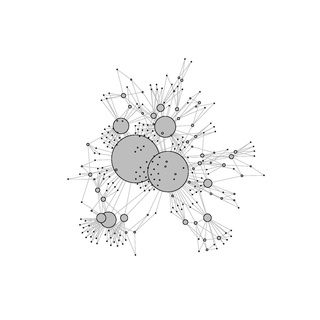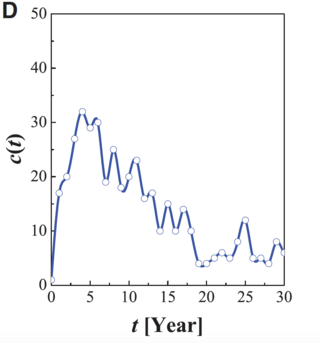Related Research Articles

A scale-free network is a network whose degree distribution follows a power law, at least asymptotically. That is, the fraction P(k) of nodes in the network having k connections to other nodes goes for large values of k as

In mathematics, computer science and network science, network theory is a part of graph theory. It defines networks as graphs where the nodes or edges possess attributes. Network theory analyses these networks over the symmetric relations or asymmetric relations between their (discrete) components.

Albert-László Barabási is a Romanian-born Hungarian-American physicist, best known for his discoveries in network science and network medicine.

In the context of network theory, a complex network is a graph (network) with non-trivial topological features—features that do not occur in simple networks such as lattices or random graphs but often occur in networks representing real systems. The study of complex networks is a young and active area of scientific research inspired largely by empirical findings of real-world networks such as computer networks, biological networks, technological networks, brain networks, climate networks and social networks.
Landauer's principle is a physical principle pertaining to the lower theoretical limit of energy consumption of computation. It holds that an irreversible change in information stored in a computer, such as merging two computational paths, dissipates a minimum amount of heat to its surroundings.

The Barabási–Albert (BA) model is an algorithm for generating random scale-free networks using a preferential attachment mechanism. Several natural and human-made systems, including the Internet, the World Wide Web, citation networks, and some social networks are thought to be approximately scale-free and certainly contain few nodes with unusually high degree as compared to the other nodes of the network. The BA model tries to explain the existence of such nodes in real networks. The algorithm is named for its inventors Albert-László Barabási and Réka Albert.
Human dynamics refer to a branch of complex systems research in statistical physics such as the movement of crowds and queues and other systems of complex human interactions including statistical modelling of human networks, including interactions over communications networks.
Matthias Staudacher is a German theoretical physicist who has done significant work in the area of quantum field theory and string theory.
In social network analysis, the co-stardom network represents the collaboration graph of film actors i.e. movie stars. The co-stardom network can be represented by an undirected graph of nodes and links. Nodes correspond to the movie star actors and two nodes are linked if they co-starred (performed) in the same movie. The links are un-directed, and can be weighted or not depending on the goals of study. If the number of times two actors appeared in a movie is needed, links are assigned weights. The co-stardom network can also be represented by a bipartite graph where nodes are of two types: actors and movies. And edges connect different types of nodes if they have a relationship. Initially the network was found to have a small-world property. Afterwards, it was discovered that it exhibits a scale-free (power-law) behavior.
Réka Albert is a Romanian-Hungarian scientist. She is a distinguished professor of physics and adjunct professor of biology at Pennsylvania State University and is noted for the Barabási–Albert model and research into scale-free networks and Boolean modeling of biological systems.
Multi-messenger astronomy is astronomy based on the coordinated observation and interpretation of signals carried by disparate "messengers": electromagnetic radiation, gravitational waves, neutrinos, and cosmic rays. They are created by different astrophysical processes, and thus reveal different information about their sources.

Scientific collaboration network is a social network where nodes are scientists and links are co-authorships as the latter is one of the most well documented forms of scientific collaboration. It is an undirected, scale-free network where the degree distribution follows a power law with an exponential cutoff – most authors are sparsely connected while a few authors are intensively connected. The network has an assortative nature – hubs tend to link to other hubs and low-degree nodes tend to link to low-degree nodes. Assortativity is not structural, meaning that it is not a consequence of the degree distribution, but it is generated by some process that governs the network’s evolution.

Individual human mobility is the study that describes how individual humans move within a network or system. The concept has been studied in a number of fields originating in the study of demographics. Understanding human mobility has many applications in diverse areas, including spread of diseases, mobile viruses, city planning, traffic engineering, financial market forecasting, and nowcasting of economic well-being.

The Bianconi–Barabási model is a model in network science that explains the growth of complex evolving networks. This model can explain that nodes with different characteristics acquire links at different rates. It predicts that a node's growth depends on its fitness and can calculate the degree distribution. The Bianconi–Barabási model is named after its inventors Ginestra Bianconi and Albert-László Barabási. This model is a variant of the Barabási–Albert model. The model can be mapped to a Bose gas and this mapping can predict a topological phase transition between a "rich-get-richer" phase and a "winner-takes-all" phase.
In a scale-free network the degree distribution follows a power law function. In some empirical examples this power-law fits the degree distribution well only in the high degree region, however for small degree nodes the empirical degree-distribution deviates from it. See for example the network of scientific citations. This deviation of the observed degree-distribution from the theoretical prediction at the low-degree region is often referred as low-degree saturation.
The initial attractiveness is a possible extension of the Barabási–Albert model. The Barabási–Albert model generates scale-free networks where the degree distribution can be described by a pure power law. However, the degree distribution of most real life networks cannot be described by a power law solely. The most common discrepancies regarding the degree distribution found in real networks are the high degree cut-off and the low degree cut-off. The inclusion of initial attractiveness in the Barabási–Albert model addresses the low-degree cut-off phenomenon.

In the scale-free network theory, a mediation-driven attachment (MDA) model appears to embody a preferential attachment rule tacitly rather than explicitly. According to MDA rule, a new node first picks a node from the existing network at random and connect itself not with that but with one of the neighbors also picked at random.

Citation dynamics describes the number of references received by the article or other scientific work over time. The citation dynamics is usually described by the bang, that take place two–three years after the work has been published, and the burst size spans several orders of magnitude. The presence of bursts is not consistent with other models based on preferential attachment. Those models are able to account for the skewed citation distribution but their reference accumulation is gradual.
Ginestra Bianconi is a network scientist and mathematical physicist, known for her work on statistical mechanics, network theory, multilayer and higher-order networks, and in particular for the Bianconi–Barabási model of growing of complex networks and for the Bose–Einstein condensation in complex networks. She is a professor of applied mathematics at Queen Mary University of London, and the editor-in-chief of Journal of Physics: Complexity.
Dashun Wang is a Professor of Management and Organizations at the Kellogg School of Management and the McCormick School of Engineering, at Northwestern University since 2016. At Kellogg from 2019, he is the Founding Director of the Center for Science of Science and Innovation (CSSI). He is also a core faculty at the Northwestern Institute on Complex Systems (NICO) and an Adjunct Professor of Department of Physics, at Northeastern University. His current research focus is on Science of Science. Dashun is a recipient of the AFOSR Young Investigator award (2016) and Poets & Quants Best 40 Under 40 Professors (2019).
References
- ↑ "Roberta Sinatra – Associate Professor @ ITU Copenhagen" . Retrieved November 5, 2021.
- 1 2 "Bio – Roberta Sinatra" . Retrieved June 7, 2022.
- ↑ "High-order markov chains in complex networks: models and applications". 123dok.org (in Italian). Retrieved November 5, 2021.
- ↑ Fortunato, Santo; Bergstrom, Carl T.; Börner, Katy; Evans, James A.; Helbing, Dirk; Milojević, Staša; Petersen, Alexander M.; Radicchi, Filippo; Sinatra, Roberta; Uzzi, Brian; Vespignani, Alessandro (March 2, 2018). "Science of science". Science. 359 (6379): eaao0185. doi:10.1126/science.aao0185. PMC 5949209 . PMID 29496846.
- ↑ Sinatra, R; Iranzo, J; Gómez-Gardeñes, J; Floría, L M; Latora, V; Moreno, Y (September 21, 2009). "The Ultimatum Game in complex networks". Journal of Statistical Mechanics: Theory and Experiment. 2009 (9): P09012. arXiv: 0807.0750 . Bibcode:2009JSMTE..09..012S. doi:10.1088/1742-5468/2009/09/p09012. ISSN 1742-5468. S2CID 15069048.
- ↑ Sinatra, Roberta; Wang, Dashun; Deville, Pierre; Song, Chaoming; Barabási, Albert-László (November 4, 2016). "Quantifying the evolution of individual scientific impact". Science. 354 (6312): aaf5239. doi: 10.1126/science.aaf5239 . PMID 27811240. S2CID 24015860.
- ↑ Deville, Pierre; Wang, Dashun; Sinatra, Roberta; Song, Chaoming; Blondel, Vincent D.; Barabási, Albert-László (April 24, 2014). "Career on the Move: Geography, Stratification and Scientific Impact". Scientific Reports. 4 (1): 4770. arXiv: 1404.6247 . Bibcode:2014NatSR...4E4770D. doi:10.1038/srep04770. ISSN 2045-2322. PMC 3998072 . PMID 24759743.
- 1 2 Janosov, Milán; Battiston, Federico; Sinatra, Roberta (December 2020). "Success and luck in creative careers". EPJ Data Science. 9 (1): 1–12. arXiv: 1909.07956 . doi: 10.1140/epjds/s13688-020-00227-w . ISSN 2193-1127. S2CID 202583344.
- ↑ Fraiberger, Samuel P.; Sinatra, Roberta; Resch, Magnus; Riedl, Christoph; Barabási, Albert-László (November 16, 2018). "Quantifying reputation and success in art". Science. 362 (6416): 825–829. Bibcode:2018Sci...362..825F. doi: 10.1126/science.aau7224 . PMID 30409804. S2CID 53242153.
- ↑ Liu, Lu; Wang, Yang; Sinatra, Roberta; Giles, C. Lee; Song, Chaoming; Wang, Dashun (July 2018). "Hot streaks in artistic, cultural, and scientific careers". Nature. 559 (7714): 396–399. arXiv: 1712.01804 . Bibcode:2018Natur.559..396L. doi:10.1038/s41586-018-0315-8. ISSN 1476-4687. PMID 29995850. S2CID 49667579.
- ↑ Huang, Junming; Gates, Alexander J.; Sinatra, Roberta; Barabási, Albert-László (March 3, 2020). "Historical comparison of gender inequality in scientific careers across countries and disciplines". Proceedings of the National Academy of Sciences. 117 (9): 4609–4616. arXiv: 1907.04103 . Bibcode:2020PNAS..117.4609H. doi: 10.1073/pnas.1914221117 . ISSN 0027-8424. PMC 7060730 . PMID 32071248.
- ↑ Elfman, Lois (February 24, 2020). "Study: Gender Inequality Persists in Science Careers and Publishing". Diverse: Issues In Higher Education. Retrieved June 7, 2022.
- ↑ Lu, Donna (September 26, 2019). "Around half of your chances of career success comes down to sheer luck". New Scientist. Retrieved June 7, 2022.
- ↑ "Sinatra Awarded ISI Fellowship | Department of Network and Data Science". networkdatascience.ceu.edu. Retrieved November 5, 2021.
- ↑ "Roberta Sinatra". isi.it. Retrieved June 7, 2022.
- ↑ "CSS Awards". cssociety.org. Retrieved November 5, 2021.
- ↑ misz. "Roberta Sinatra receives CSS award | NEtwoRks, Data, and Society (NERDS)" . Retrieved November 5, 2021.